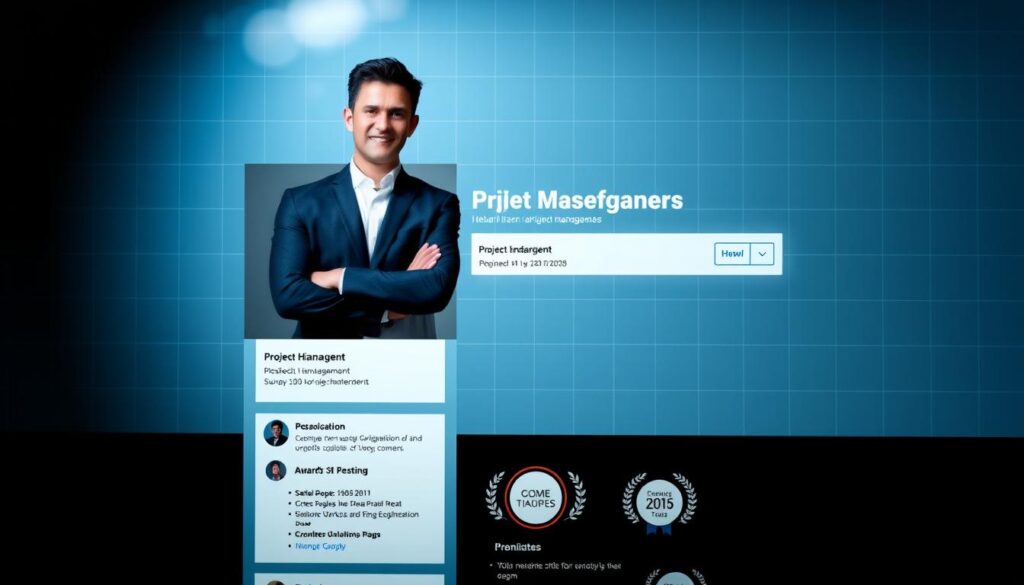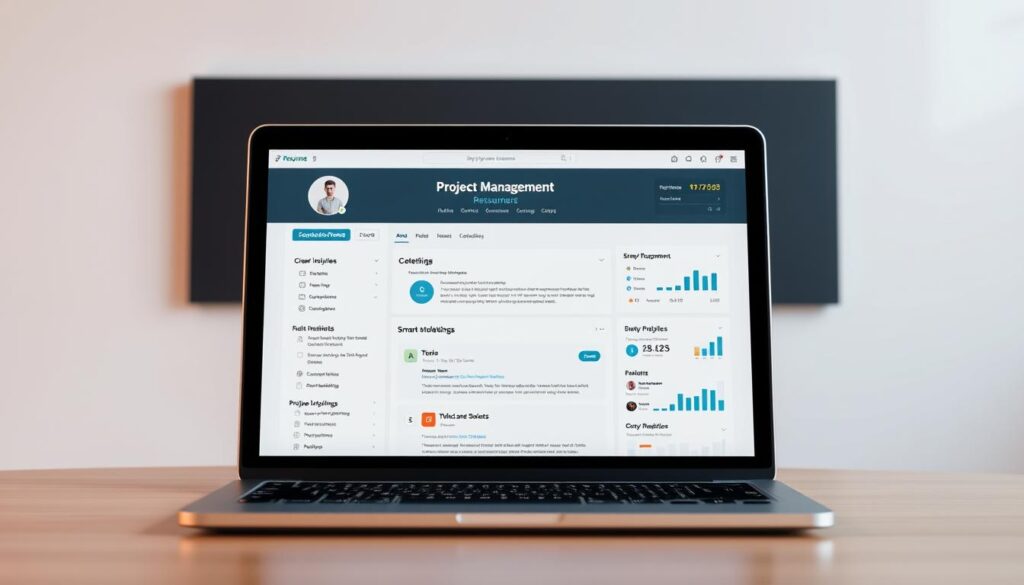What if the skills that got you hired yesterday won’t land your dream role tomorrow? With 22 million new positions emerging in organizational leadership fields over the next decade, standing out requires more than traditional resumes. The global talent gap in team coordination roles could drain $208 billion from businesses – but this crisis creates your golden opportunity.
Modern employers prioritize candidates who combine technical expertise with adaptive thinking. Our analysis reveals 73% of hiring managers now value strategic problem-solving over certifications alone. You’ll need to demonstrate how you translate plans into measurable outcomes while navigating hybrid work environments.
This guide decodes what leading companies truly want from applicants in leadership positions. We’ll show you how to align your experience with emerging priorities like AI-driven workflows and cross-functional collaboration. Ready to roboapply these insights? Our tools automate application tailoring while preserving your unique professional voice.
Key Takeaways
- Industry growth exceeds 33% with millions of unfilled positions globally
- Employers prioritize strategic thinking over basic certification checks
- Automated tools streamline application processes without losing personalization
- Hybrid work models demand new proof points for remote leadership skills
- Salary benchmarks rose 18% for roles requiring digital transformation experience
Understanding the Project Management Landscape
Navigating today’s dynamic organizational leadership roles requires understanding where demand meets opportunity. Employers now prioritize candidates who align their expertise with sector-specific needs, making industry awareness critical for career growth.
Current Job Market Trends
Digital transformation drives hiring across sectors, with 63% of companies expanding teams to manage AI-integrated workflows. Hybrid work models have reshaped expectations—proficiency in remote collaboration tools now rivals traditional planning skills in importance.
Salary benchmarks rose 22% in tech and healthcare roles over the past year. Focus on industries requiring compliance expertise or infrastructure development, as these areas show sustained growth despite economic fluctuations.
Key Industries Hiring Project Managers
Construction leads demand, particularly for professionals skilled in commercial and green energy projects. Technology firms seek leaders who can scale agile frameworks, while healthcare organizations value experience with regulatory changes.
Energy and transportation sectors offer stability, with government investments fueling new initiatives. Finance institutions prioritize risk management specialists—highlight these competencies if targeting banking roles. For tailored guidance, review strategic resume objectives matching your target sector.
Align your portfolio with industry pain points. Construction roles emphasize budget adherence, while tech positions value innovation metrics. This focus helps hiring teams quickly see your relevance to their specific challenges.
Exploring project manager job search insights and tips
Customization separates contenders from frontrunners in today’s competitive market. Employers receive 250+ applications per opening, making precision targeting essential for visibility.

Tailoring Your Message for the Role
Start by reverse-engineering position descriptions. Identify three recurring requirements across postings in your target sector. Mirror this language in your resume summary and cover letter opening.
Tech companies prioritizing agile transformations want concrete metrics. Highlight how you accelerated release cycles by 40% or reduced sprint planning time. Healthcare organizations value compliance documentation – quantify audit success rates.
- Use company earnings calls to identify current initiatives
- Align past achievements with stated organizational goals
- Replace generic “team leadership” with role-specific competencies
Digital portfolios now influence 58% of hiring decisions. Create case studies showing your problem-solving process from initial roadblock to measurable outcome. Pair these with a dynamically optimized resume that adjusts emphasis based on application requirements.
Network strategically through industry-specific LinkedIn groups before applying. Reference recent company announcements during interviews to demonstrate proactive research. This layered approach makes your candidacy memorable across multiple touchpoints.
Crafting a Standout Resume for Project Management Positions
What separates a forgettable resume from one that commands attention? Hiring teams scan documents in under seven seconds—your content must deliver immediate clarity and value.
Highlighting Quantifiable Achievements
Replace generic task lists with specific metrics that demonstrate business impact. Use this formula: Action + Measurement + Result. For example:
- Cut software development costs by 19% through vendor renegotiations ($217K annual savings)
- Accelerated product launches by 33% using hybrid agile-waterfall frameworks
- Improved cross-department alignment, reducing meeting hours by 12 weekly
Prioritize outcomes employers care about: revenue growth, risk mitigation, and stakeholder satisfaction. Avoid vague claims like “improved efficiency”—show the math.
Emphasizing Relevant Certifications
List credentials that validate your technical expertise and leadership capabilities. PMP certification holders earn 22% more on average than non-certified peers. Structure your education section like this:
- PMP – Project Management Institute (2023)
- PRINCE2 Practitioner – AXELOS (2022)
- Agile Certified Practitioner – PMI (2024)
Include 36 real-world resume examples showing how to position certifications alongside practical experience. Recent graduates should lead with CAPM credentials, while seasoned professionals highlight PMP status.
Optimizing Your LinkedIn & Digital Profiles for Project Manager Roles
Your digital footprint now serves as your first interview in today’s hiring landscape. Recruiters spend 19 seconds scanning profiles before deciding to engage, making precision optimization non-negotiable. These strategies turn your online presence into a career accelerator.

Enhancing Your Online Presence
Revamp your LinkedIn headline using role-specific keywords like “Cross-Functional Team Leadership” or “Agile Implementation Specialist”. Mirror language from target job descriptions while maintaining readability. For example:
- Original: Project Manager at XYZ Corp
- Optimized: PMP-Certified Leader | Delivering 28% Faster Tech Deployments
Craft your summary section as a value proposition. Highlight three measurable achievements using the Challenge-Action-Result framework. Include percentages, timelines, and stakeholder impacts. Update your Featured section weekly with work samples demonstrating process improvements.
Utilizing Internal Networking Tools
Join five PMI discussion groups related to your industry focus. Engage daily by commenting on posts from hiring managers – focus on adding insights rather than generic praise. Use LinkedIn’s Open Profile feature when applying through the Jobs tab to bypass connection requirements.
Sync your profile with your strategic resume alignment for consistency. Enable Creator Mode to share short videos explaining complex workflows. Recruiters report 47% higher response rates when candidates showcase thought leadership through native content.
Networking Strategies for Project Managers
Strategic connections often unlock opportunities before they’re publicly listed. Effective relationship-building turns casual contacts into career accelerators, especially in leadership-focused fields. Focus on quality interactions that demonstrate your expertise while learning from others’ industry experience.
Building a Robust Professional Network
Start with PMI chapter meetings—these gatherings connect you with peers facing similar challenges. Share specific examples of how you’ve streamlined workflows or resolved conflicts. Ask thoughtful questions that show genuine interest in others’ approaches.
Join niche LinkedIn groups focused on your sector. Comment weekly on discussions with actionable insights rather than generic replies. For instance: “Your agile scaling method aligns with what worked in my healthcare rollout—let’s discuss risk mitigation parallels.”
Engaging in Industry-Specific Events
Target conferences addressing current pain points like AI integration or hybrid team coordination. Prepare three conversation starters tied to session topics. Collect business cards, then follow up within 48 hours with personalized references to your discussion.
Volunteer as a panel moderator or workshop facilitator. This positions you as a knowledge source while expanding connections. Track interactions using CRM tools, noting shared interests for future outreach.
Successful professionals often credit relationships for career breakthroughs. As noted in a comprehensive hiring guide, 68% of leadership roles fill through referrals. Consistent, value-driven engagement keeps you top-of-mind when openings arise.
Leveraging RoboApply's Features for a Smarter Job Search
Transform your application strategy with intelligent tools designed for modern career challenges. RoboApply’s suite cuts hours from your weekly search while boosting response rates through precision optimization.

AI Resume & Cover Letter Builder
The platform’s AI analyzes job descriptions to identify critical keywords for your project management portfolio. It suggests achievements from your experience that align with employer priorities. For example:
- Automatically inserts relevant certifications like PMP or Scrum Master
- Generates multiple cover letter versions tailored to different industries
- Flags missing skills compared to similar successful applicants
One user reported landing 3 interviews weekly after using the automation platform to highlight cloud migration expertise. The system updates your materials as you add new accomplishments.
ATS Optimization and Auto-Apply Chrome Extension
RoboApply reformats resumes to bypass rejection filters used by 98% of Fortune 500 companies. Its Chrome extension lets you apply to roles in one click while maintaining personalized touches.
The tracking dashboard monitors application status across 50+ boards. Set reminders for follow-ups using templated messages that preserve professionalism. Combine these resources with comprehensive strategies to accelerate your timeline.
Real-time grammar checks and interview prep modules complete your toolkit. This integrated approach helps you focus on career growth rather than administrative tasks.
Utilizing Multiple Job Boards & Application Tracking Tools
Maximizing your professional reach requires casting a strategic net across multiple platforms. General boards like Indeed and Glassdoor expose you to diverse industries, while specialized hubs like PMI’s portal focus on leadership roles needing specific expertise.
Create separate search profiles for each platform. Use title variations like “Program Lead” or “Implementation Specialist” alongside your primary target role. Set daily alerts for “remote coordination” or “agile deployment” to catch new postings within minutes.
Organize your efforts using tracking software like Trello or Airtable. Color-code applications by stage: submitted, interviewed, declined. This visual system prevents duplicate submissions and ensures timely follow-ups. For structured guidance, explore this step-by-step framework to streamline your process.
Balance volume with precision by:
- Saving customized search filters on each platform
- Scheduling 30-minute daily application blocks
- Prioritizing roles posted within the last 72 hours
Leverage tracking templates to maintain consistent communication records. Note hiring manager names, application dates, and unique role requirements. This organized approach demonstrates the operational excellence employers expect in leadership positions.
Effective Communication: Engaging Stakeholders & Team Members
Clear communication bridges the gap between plans and results in leadership roles. Leaders who articulate goals while listening to concerns build trust across all levels. This alignment turns complex initiatives into achievable milestones.
Mastering Stakeholder Conversations
Start every discussion by defining success metrics. Use simple language to explain technical processes, ensuring team members and executives share the same vision. Schedule brief weekly updates to maintain momentum without overwhelming schedules.
Active listening proves crucial. Repeat key points from stakeholders to confirm understanding. For remote teams, leverage video calls to read nonverbal cues. Document decisions in shared drives for transparency.
Visual tools like Gantt charts simplify progress tracking. Pair these with concise written summaries highlighting risks and adjustments. Tools like tailored communication templates ensure consistency across channels.
Adapt your approach based on audience needs. Technical teams require detailed workflows, while executives focus on ROI. This flexibility strengthens management skills and drives business outcomes. Regular feedback loops refine strategies over time, creating a culture of continuous improvement.
FAQ
How do I highlight certifications like PMP® on my resume?
Place certifications under a dedicated “Certifications” section near the top of your resume. Include full names (e.g., Project Management Professional®), issuing organizations, and dates. For hybrid roles, prioritize credentials relevant to the industry, such as Certified ScrumMaster® for tech positions.
What LinkedIn strategies attract recruiters for leadership roles?
Use industry-specific keywords like Agile transformation or cross-functional team leadership in your headline and summary. Showcase measurable achievements in the “Experience” section, and join groups like PMI® or Scrum Alliance to increase visibility to hiring managers.
Can RoboApply’s AI tools help with ATS optimization?
Yes. RoboApply’s AI Resume Builder scans job descriptions to align your skills with keywords like risk mitigation or stakeholder engagement. The Auto-Apply Chrome Extension tracks applications across platforms like Indeed and LinkedIn while ensuring ATS-friendly formatting.
Which industries have the highest demand for project managers?
Healthcare, IT, and construction currently lead in hiring. For example, tech firms seek professionals with Jira and DevOps experience, while healthcare values HIPAA-compliant project tracking expertise. Tailor your portfolio to match sector-specific tools and regulations.
How do I prepare for behavioral interviews about team conflicts?
Use the STAR method (Situation, Task, Action, Result) to structure responses. Example: Describe how you mediated a stakeholder disagreement using active listening and created a revised timeline in Microsoft Project, improving team productivity by 30%.
What networking events are most effective for remote roles?
Attend virtual conferences like Digital PM Summit or webinars hosted by platforms like Asana. Engage in LinkedIn discussions about remote team management tools (e.g., Trello, Slack) to connect with hiring managers in distributed organizations.


















